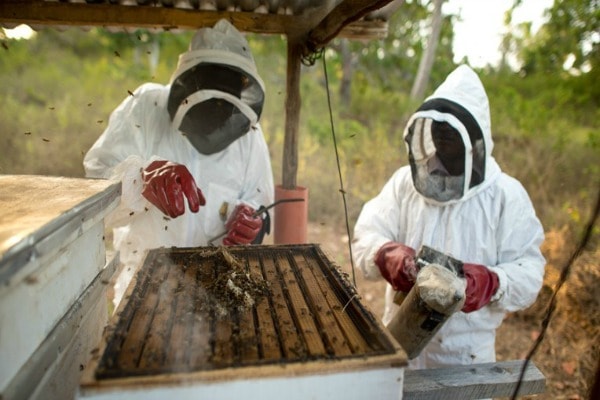Bee farming and keeping in Africa is one sector of agriculture on the continent that has great economic and environmental potential in terms of creating sustainable business and employment while protecting the livelihood of bees.
Bees are not only important for the production of honey, which is the world’s most popular natural sweetener, but also for the pollination of plants. Without the bees’ natural role, food production would be at risk as bees pollinate approximately 35% of food crops consumed by humans, and farmers would have to find unsustainable, and often harmful, practices to the environment to produce bee products such as honey and beeswax.


The value of global trade of honey, besides other bee products, is estimated to be over $600 million, and in Africa, honey is produced in Ethiopia, Kenya, and Tanzania, which are the largest honey producers on the continent, and in large markets like Nigeria and South Africa, both having a high demand for honey.
Other products that bees produce that are in high demand include beeswax, which is widely used in both the skincare and cosmetic industries, as well as in shoe, furniture and candle manufacturing, propolis, which is used in medicines and cosmetic products, and honey bee venom, also known as apitoxin, commonly used as treatment for rheumatism and other joint diseases, as well as desensitizing people who are allergic to bee stings and insect bites.


According to Pretoria-based bee farmer and entrepreneur, Portia Morudi, a bee farmer takes care of bees for honey production and pollination. Being based in the agricultural community of Winterveld, Morudi is able to involve the community in her business as she places beehives free of charge on farms that grow crops in order to provide bees that will pollinate and ensure the healthy growth of crops and improve yields. Most of the farmers in Winterveld are citrus farmers.
Once honey is extracted from the beeswax honeycomb in framed beehives, it goes into a settling tank before it is bottled and sold. Initially as a rural farmer, Morudi did not have access to markets to sell her honey, known as Iliju Honey, which led her to forming a market labeled, The Village Market SA. Not only does the market sell her honey, but the market is also a place for farmers in the community to sell their products. The market is in the community of Winterveld so that visitors can interact with and experience the community.
Watch how Portia Morudi’s business benefits the Winterveld community.
Bee farming in Kenya is lucrative as farmers generate a significant income and don’t need large capital or land to enter into bee farming. Because of this, the sector attracts approximately 70% of youth and 50% of women.
Not only is honey the income-generating product from bee farming, but also propolis, bee venom and royal jelly, as well as other products. Farmers are trained in making products such as beeswax and cosmetic products from bee products.
While domestic business was thriving due to high demand, exports took a hit in 2008 after Kenya was banned from exporting honey to the European Union in 2008 due to excessive use of pesticides. It transformed the industry through encouraging farmers to use more natural and environmentally-friendly pesticides that would not negatively affect bees when they forage on crops and plants, and this, in turn, will ensure healthier honey and other bee products.
An in-depth look at Kenya’s bee farming sector:
Africa’s leading honey and beeswax producer is Ethiopia; however, honey production is still largely traditional, only reaching around 10% of its potential. Various projects, including the International Centre of Insect Physiology and Ecology (ICIPE), as well as the MasterCard Foundation, are assisting farmers with technical training and modern beehives to increase productivity and yield.
Modernizing bee farming has had a positive impact on attracting women into the sector who were previously discouraged by traditional honey harvesting methods which included climbing trees to get honeycombs. Women have also been encouraged into the sector through assistance in accessing funding and land for their business ventures.
An interesting domestic product and export and delicacy in the Tigray Region is white honey, which is produced using a blossom from the sage plant family. Other types of honey include raw white honey, red raw honey, and raw yellow honey. Honey’s main domestic use is for the production of Tej, Ethiopia’s popular honey wine.
The farmers’ main source of income is from bee farming and selling the product locally, which accounts for 90% of all sales. However, problems such as deforestation and climate change are existing threats that result in a smaller yield and low seasonal production.
